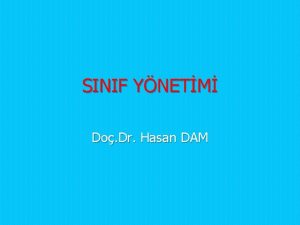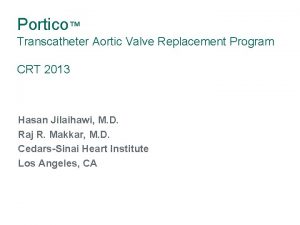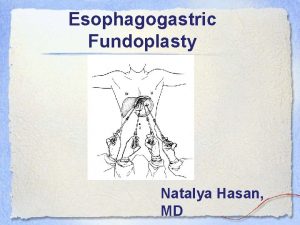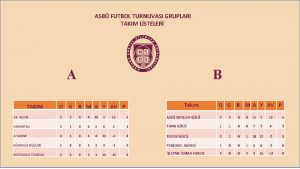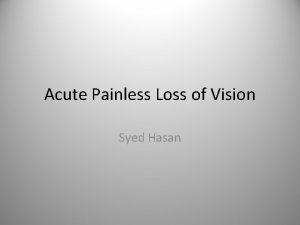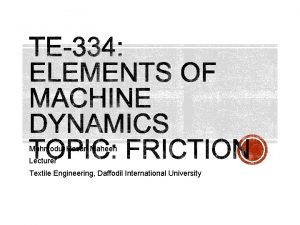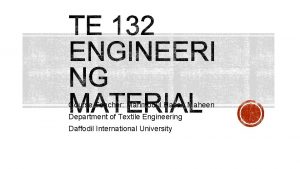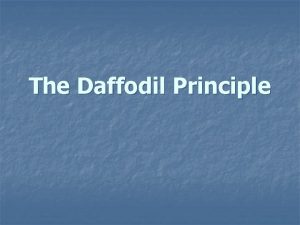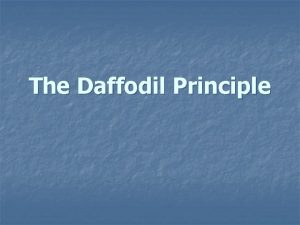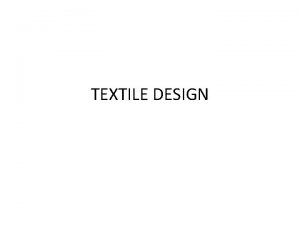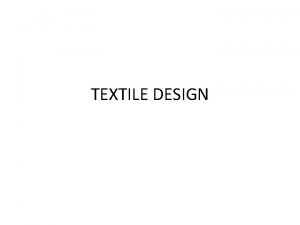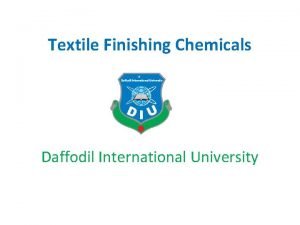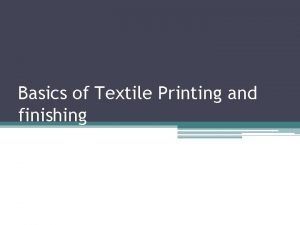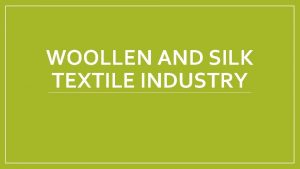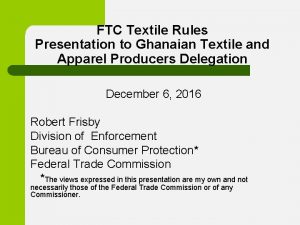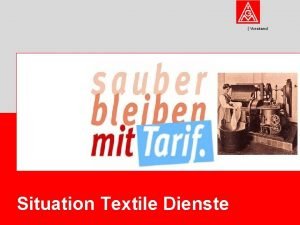Mahmodul Hasan Maheen Lecturer Textile Engineering Daffodil International






































- Slides: 38

Mahmodul Hasan Maheen Lecturer, Textile Engineering Daffodil International University


STRESS

NORMAL STRESS Here, load F is perpendicular to the material surface

SHEAR STRESS Shear Stress § When the resultant of internal forces acts in the direction parallel to the reaction plane, the stress is called shear stress, denoted by ‘τ’. Here, load F is parallel to the material surface

§ Strength is mechanical property of material. § It’s the stress a material can bear without being ruptured. § Strength is the maximum stress carrying capacity of a material

STRAIN ∆L F F ∆L

STRESS-STRAIN CURVE Figure : Typical stress-strain curve for mild steel

Tensile stress-train curves for different materials. Note that these are qualitative.

Stress-Strain Behavior of Mild Steel STRESS-STRAIN BEHAVIOR § Proportional limit The limit upto which stress is proportional to strain (point P). § Elastic limit The limiting stress beyond which a material cannot be stressed without causing a permanent deformation (point A). • Yield point The point at which there is an appreciable elongation or yielding of the material without any corresponding increase of load. • The stress corresponding to point B is the upper yield point. • The stress corresponding to point C is the lower yield point. § Yield Stress The stress corresponding to yield point is called yield strength. Lower yield point is used to determine the yield strength of a material. § Ultimate strength It is the highest stress that a material can withstand (point D). § Rupture or Breaking strength The stress at which the specimen breaks (point E). § Actual rupture or breaking strength If the load is divided by the true section area as the specimen narrows down after the ultimate strength, the stress will follow the dotted line as shown in figure. If the rupture area is measured after the failure and the load is divided by this area, the stress obtained is called actual rupture of breaking strength.

§ Engineering stress is the applied load divided by the original cross-sectional area of a material. Also known as nominal stress. § True stress is the applied load divided by the actual cross-sectional area (the changing area with respect to time) of the specimen at that load. § Engineering strain is the amount that a material deforms per unit length in a tensile test. Also known as nominal strain. True strain equals the natural log of the quotient of current length over the original length

TRUE STRESS § Where, Ai is the actual area of the cross-section corresponding to load P True Strain

HOOK’S LAW §

STRESS-STRAIN BEHAVIOR Modulus of Elasticity and Modulus of Rigidity

§ Problem 1 § Convert the change in length data in Table to engineering stress and strain and plot a stressstrain curve.


Problem 2 § Compare engineering stress and strain with true stress and strain for the aluminium alloy. 0. 505 -in. diameter test bar, initial length lo = 2 in. § (a) the maximum load and § (b) fracture. § The diameter at maximum load is 0. 4905 in. and at fracture is 0. 398 in.


§ Alternative way:


§ Up until the point of necking in a tensile test, the engineering stress is less than the corresponding true stress, and the engineering strain is greater than the corresponding true strain. § It was necessary to use the instantaneous dimensions to calculate the true stress and strain, since failure occurs past the point of necking. After necking, the true strain is greater than the corresponding engineering strain

PROBLEMS: Solving Techniques: 1. Write down the related equations. 2. Focus on their units. 3. Use the formulas to find the desired values. Problem No. 1: If the strength of a circular rod in 400 MPa, then what should be the minimum radius of the rod if it is subjected to 100 N load? Problem No. 2: If a load of 100 N is subjected to a square column where the size of each side is 0. 55 mm. You have two materials : Iron ( Strength=350 MPa) and Copper ( Strength=230 MPa). Which material should you choose? Problem No. 3: A load of 100 N is applied on a Nylon rope of 10 m long and 1 mm radius. If Modulus of Elasticity ( Young’s Modulus) of Nylon is 3 GPa, then find the elongation of the rope.

ELASTICITY & PLASTICITY • Elasticity is the ability of a body to resist a distorting influence or deforming force and to return to its original size and shape when that influence or force is removed. • Plasticity is the property of a solid material to undergo permanent deformation under load.

DUCTILE AND BRITTLE MATERIAL § Ductile Materials have high strain. Ex-Steel , Aluminum § Brittle Materials have low strain. Ex-Glass, Cast Iron

MODULUS OF RESILIENCE §

MODULUS OF TOUGHNESS §

§ As we apply stress to a material, the material initially exhibits elastic deformation. The strain that develops is completely recovered when the applied stress is removed. § As we continue to increase the applied stress, the material eventually “yields” to the applied stress and exhibits both elastic and plastic deformation. § The critical stress value needed to initiate plastic deformation is defined as the elastic limit of the material. § The proportional limit is defined as the level of stress above which the relationship between stress and strain is not linear. § A yield strength or yield point of a material is defined as the stress at which a material begins to deform plastically. § Prior to the yield point the material will deform elastically and will return to its original shape when the applied stress is removed. Once the yield point is passed, some fraction of the deformation will be permanent and nonreversible. § The stress obtained at the highest applied force is the tensile strength(S), which is the maximum stress on the engineering stress-strain curve. This value is also commonly known as the ultimate tensile strength.


§ The stiffness of a component is proportional to its Young’s modulus. § A component with a high modulus of elasticity will show much smaller changes in dimensions if the applied stress causes only elastic deformation when compared to a component with a lower elastic modulus. § Ductility is the ability of a material to be permanently deformed without breaking when a force is applied.

FATIGUE § If the maximum stress in the specimen does not exceed the elastic limit of the material, the specimen returns to its initial condition when the load is removed. § What will happen if a load lower than the strength of the material is repeated for thousands or millions of times? § When a load lower than the strength of the material is repeated for thousands or millions of times rupture will occur at a stress much lower than the static breaking strength; this phenomenon is known as fatigue. A fatigue failure is of a brittle nature, even for materials that are normally ductile.

FATIGUE Ø Fatigue Strength (Endurance Limit): § The maximum stress which can be applied to a material for an infinite number of stress cycles without resulting in failure of the material is called its fatigue strength or endurance limit. § Loading & unloading at a fast rate can leave residual strain in the material even at moderate stress levels. § When a material is subjected to repeated (and reversed) loading at significantly high stress levels, plastic deformation occurs in microscopic (molecular) level. It causes microscopic cracks in the material leading to fatigue failure.

FATIGUE v For a low-carbon steel, such as structural steel, the endurance limit is about one-half of the ultimate strength of the steel. v For nonferrous metals, such as aluminum and copper, a typical curve shows that the stress at failure continues to decrease as the number of loading cycles is increased. § For such metals, one defines the fatigue limit as the stress corresponding to failure after a specified number of loading cycles, such as 5 x 107 cycles.

CREEP • The stress-dependent part of the plastic deformation is referred to as slip, and the time-dependent part—which is also influenced by the temperature—as creep. • Creep is the time-dependent deformation at elevated temperature and constant stress q Creep is the tendency of a material to deform permanently under the influence of mechanical stresses. It can occur as a result of long-term exposure to high levels of stress that are still below the yield strength of the material. § Creep of a turbine blade will cause the blade to contact the casing, resulting in the failure of the blade. § Boiler steam tube failures, solder joint failures are some other examples.

STRESS CONCENTRATION § § A stress concentration is a location in an object where stress is concentrated. When a structural member contains a discontinuity, such as a hole or a sudden change in cross section, high localized stresses can also occur near the discontinuity. Stress concentration can occur in cracks in an object and crack can propagate due to high localized stress in these cracks. § Fillets can be used to minimize stress concentration as degree of discontinuity decreases.

WEAR Wear is erosion or sideways displacement of material from its surface and original position on a solid surface performed by the action of another surface. § Wear of metals occurs by the plastic displacement of surface and near-surface material. Ø Some common mechanisms: 1. Adhesion: bodies slide over and pressed into. 2. Abrasion: a hard rough surface slides across a softer surface causing cutting or fragmentation. 3. Fretting: repeated cyclical rubbing between two surfaces causing fatigue. 4. Erosive wear: caused by impact of particles of solid or liquid against the surface of an object. 5. Surface fatigue: surface is weakened by cyclic loading followed by micro-crack growths. § These mechanisms are not independent or mutually exclusive. §

HARDNESS § Hardness is the resistance of a material to wear, machining, cutting, scratching, indentation. § Hardness is the resistance of material surfaces to plastic deformation by indentation. It is the property that allows materials to resist being deformed permanently when a load is applied. Metal strength is proportional to hardness, on the other hand toughness decreases with the increase of it. § The followings are the most common hardness test methods used in today`s technology: • Rockwell, Brinell, Vickers, Knoop, Shore etc.

THATS ENOUGH FOR TODAY!!! q. Query? q. Questions? ? q. Problems? ? ?

THANK YOU
 Lecturer's name
Lecturer's name Daffodil university cse course
Daffodil university cse course The daffodil principle
The daffodil principle List of official compendia in pharmacy
List of official compendia in pharmacy What is the summary of the poem daffodils
What is the summary of the poem daffodils Daffodil replicator
Daffodil replicator Cabbaca
Cabbaca Jeannie watkins
Jeannie watkins Spe distinguished lecturer
Spe distinguished lecturer Good afternoon student
Good afternoon student Photography lecturer
Photography lecturer Lecturer in charge
Lecturer in charge Designation lecturer
Designation lecturer Designation of lecturer
Designation of lecturer Gcwak
Gcwak Lecturer name
Lecturer name Pearson lecturer resources
Pearson lecturer resources Spe distinguished lecturer
Spe distinguished lecturer Lector vs lecturer
Lector vs lecturer Lecturer in charge
Lecturer in charge Cfa lecturer handbook
Cfa lecturer handbook Lecturer asad ali
Lecturer asad ali Hasan dam
Hasan dam Hasan berke atalay
Hasan berke atalay Portico
Portico Zahid hasan diu
Zahid hasan diu Abdul qadir hasan baraja
Abdul qadir hasan baraja Dr hasan hafizur rahman
Dr hasan hafizur rahman What is diploid
What is diploid Fundoplasty
Fundoplasty Emir hasan ölmez
Emir hasan ölmez Hasan mohiaddin
Hasan mohiaddin Terdilat
Terdilat Amiodrone
Amiodrone Te mirat publike
Te mirat publike Hasan korkmaz ifl
Hasan korkmaz ifl Dr bushra hasan
Dr bushra hasan Akhtar and hasan
Akhtar and hasan Raja hasan saregamapa
Raja hasan saregamapa






















